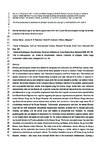Did the Kyrenia Range of northern Cyprus rotate with the Troodos-Hatay microplate during the tectonic evolution of the eastern Mediterranean?
| dc.contributor.author | Morris, A | |
| dc.contributor.author | Robertson, AHF | |
| dc.contributor.author | Anderson, Mark | |
| dc.contributor.author | Hodgson, E | |
| dc.date.accessioned | 2016-07-19T15:00:56Z | |
| dc.date.available | 2016-07-19T15:00:56Z | |
| dc.date.issued | 2015-06-13 | |
| dc.identifier.issn | 1437-3254 | |
| dc.identifier.issn | 1437-3262 | |
| dc.identifier.uri | http://hdl.handle.net/10026.1/5082 | |
| dc.description.abstract |
Previous palaeomagnetic studies have allowed the recognition of a distinctive area of Neotethyan oceanic rocks, including the Troodos ophiolite in Cyprus and the Hatay ophiolite to the east in southern Turkey, that underwent 90° of anticlockwise rotation between Late Cretaceous (Campanian) and Early Eocene time. The southern and western boundaries of this rotated Troodos–Hatay microplate have been inferred to lie within, or adjacent to, zones of deformed oceanic and continental margin rocks that are now exposed in southern and western Cyprus; however, the northern boundary of the microplate remains undefined. Relevant to this problem, palaeomagnetic data are presented here from basaltic lavas exposed along the Kyrenia Range, mostly from Late Cretaceous (Maastrichtian) sites and one Eocene site. A positive inclination-only fold test demonstrates that remanences are pre-deformational in age, and positive conglomerate tests show that magnetic remanences were acquired before Late Eocene–Early Oligocene time, together suggesting that primary magnetizations are preserved. Data from the eastern Kyrenia Range and the Karpas Peninsula (the easternmost extension of the Kyrenia Range) document significant relative tectonic rotation between these localities, with no rotation in the eastern range versus 30° of anticlockwise rotation of the Karpas Peninsula. Unfortunately, palaeomagnetic sites from the western Kyrenia Range did not yield tectonically interpretable magnetization directions, probably due to complex poly-phase thrusting and folding, and the central range also yielded no interpretable data. However, the available palaeomagnetic data are sufficient to demonstrate that the Kyrenia terrane underwent a separate rotation history to the Troodos–Hatay microplate and also implies that the northern boundary of the Troodos–Hatay microplate was located between the Troodos ophiolite and the Kyrenia Range. The former microplate margin has since been overridden and concealed by two phases of southwards thrusting and folding of the Kyrenia Range units (Mid-Eocene; latest Miocene–earliest Pliocene). The likely cause of the anticlockwise rotation affecting the Karpas Peninsula, and by implication the curvature of the Kyrenia Range as a whole, relates to regional late-stage subduction and diachronous continental collision. The Southern Neotethys sutured in SE Turkey during the Early Miocene, whereas a relict ocean basin remained further west in the easternmost Mediterranean, allowing a remnant N-dipping subduction zone to retreat southwards and so induce the present-day arcuate shape of the Kyrenia Range. | |
| dc.format.extent | 399-415 | |
| dc.language | en | |
| dc.language.iso | en | |
| dc.publisher | Springer Science and Business Media LLC | |
| dc.subject | Palaeomagnetism | |
| dc.subject | Rotation | |
| dc.subject | Kyrenia Range | |
| dc.subject | Troodos | |
| dc.subject | Cyprus | |
| dc.subject | Eastern Mediterranean | |
| dc.subject | Tethys | |
| dc.subject | Tectonics | |
| dc.subject | Microplate | |
| dc.title | Did the Kyrenia Range of northern Cyprus rotate with the Troodos-Hatay microplate during the tectonic evolution of the eastern Mediterranean? | |
| dc.type | journal-article | |
| dc.type | Journal Article | |
| plymouth.author-url | http://gateway.webofknowledge.com/gateway/Gateway.cgi?GWVersion=2&SrcApp=PARTNER_APP&SrcAuth=LinksAMR&KeyUT=WOS:000368178700017&DestLinkType=FullRecord&DestApp=ALL_WOS&UsrCustomerID=11bb513d99f797142bcfeffcc58ea008 | |
| plymouth.issue | 1 | |
| plymouth.volume | 105 | |
| plymouth.publication-status | Published | |
| plymouth.journal | INTERNATIONAL JOURNAL OF EARTH SCIENCES | |
| dc.identifier.doi | 10.1007/s00531-015-1208-9 | |
| plymouth.organisational-group | /Plymouth | |
| plymouth.organisational-group | /Plymouth/Faculty of Science and Engineering | |
| plymouth.organisational-group | /Plymouth/Faculty of Science and Engineering/School of Geography, Earth and Environmental Sciences | |
| plymouth.organisational-group | /Plymouth/REF 2021 Researchers by UoA | |
| plymouth.organisational-group | /Plymouth/REF 2021 Researchers by UoA/UoA07 Earth Systems and Environmental Sciences | |
| plymouth.organisational-group | /Plymouth/Research Groups | |
| plymouth.organisational-group | /Plymouth/Research Groups/Marine Institute | |
| plymouth.organisational-group | /Plymouth/Users by role | |
| plymouth.organisational-group | /Plymouth/Users by role/Academics | |
| plymouth.organisational-group | /Plymouth/Users by role/Researchers in ResearchFish submission | |
| dcterms.dateAccepted | 2015-05-24 | |
| dc.identifier.eissn | 1437-3262 | |
| dc.rights.embargoperiod | No embargo | |
| rioxxterms.versionofrecord | 10.1007/s00531-015-1208-9 | |
| rioxxterms.licenseref.uri | http://www.rioxx.net/licenses/all-rights-reserved | |
| rioxxterms.licenseref.startdate | 2015-06-13 | |
| rioxxterms.type | Journal Article/Review |


